Alice Y. Chen's Blog, page 16
July 31, 2014
SHOW, don’t TELL.
As I mentioned in my last post, an important part of writing children’s books is to test it out on kids who are in the age range of your book. Writing for the 3-7 year age range means writing in a different language than for ages 1-3 or 8-11. The ecology of kids is so vastly different from one age group to the next; you all know this from having been a kid. But determining this up front is critical to the success of the book, because it dictates how many words you use, which words you will use, the style of illustration…EVERY detail, EVERY punctuation mark, EVERYTHING.
The most recent trend in word count is economy. Picture books used to contain 1500+ worded stories. Now all the publishers and agents say to keep it under 1,000; even better if under 500. At the same time, you are supposed to “show” and not “tell” your story. Take a look at the pictorial example I have drawn up especially for this post for when you are writing how a character feels:
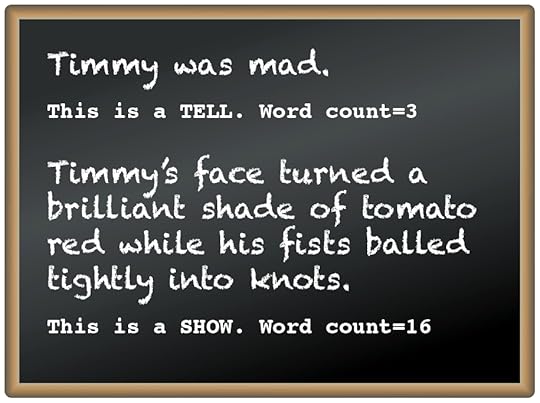
Does this add up to you?
In short, it is up to YOU as the writer to find that happy medium between word count and showing, not telling.
FYI, Centipede Dragon, A Benevolent Creature clocks in at 704 words. Boo-YAH.
The most recent trend in word count is economy. Picture books used to contain 1500+ worded stories. Now all the publishers and agents say to keep it under 1,000; even better if under 500. At the same time, you are supposed to “show” and not “tell” your story. Take a look at the pictorial example I have drawn up especially for this post for when you are writing how a character feels:

Does this add up to you?
In short, it is up to YOU as the writer to find that happy medium between word count and showing, not telling.
FYI, Centipede Dragon, A Benevolent Creature clocks in at 704 words. Boo-YAH.
Published on July 31, 2014 06:26
July 29, 2014
Thanking the Academy, part 2
With all the work on storyline, character development, drawing, re-drawing, and re-writing I had done to this point, you might be shocked to learn that I hadn’t actually SHOWN the book TO a kid.
The truth is I was afraid. Afraid that a kid, in the way that kids are very straightforward, would straightforwardly tell me that my book was crap. When I finally broke down and showed it to my friend Grace’s kid, Daniel, I had visions of him throwing it to the ground, stomping furiously upon it and declaring it rubbish. Which is sometimes what I felt I wanted to do to it.
Minutes of agony went by as he paged through the book, lips moving, eyebrows going up, then back down…
Daniel was thinking two thumbs UP. A huge first hurdle to cross, for testing your book out on its target audience is rather key to knowing if your book would be interesting to a kid. Admittedly, Daniel was a little older than my target age group (he was nine), so I wasn’t yet out of the woods. In my giddiness, I asked if there was anything he’d like to see changed? Though this question took him off guard, he was ready with suggestions. So, here are Daniel’s direct contributions to the book!
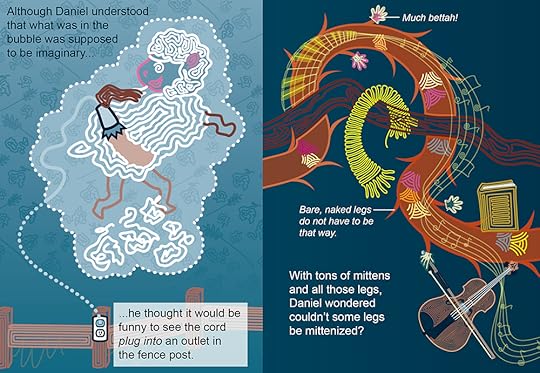
The truth is I was afraid. Afraid that a kid, in the way that kids are very straightforward, would straightforwardly tell me that my book was crap. When I finally broke down and showed it to my friend Grace’s kid, Daniel, I had visions of him throwing it to the ground, stomping furiously upon it and declaring it rubbish. Which is sometimes what I felt I wanted to do to it.
Minutes of agony went by as he paged through the book, lips moving, eyebrows going up, then back down…
Daniel was thinking two thumbs UP. A huge first hurdle to cross, for testing your book out on its target audience is rather key to knowing if your book would be interesting to a kid. Admittedly, Daniel was a little older than my target age group (he was nine), so I wasn’t yet out of the woods. In my giddiness, I asked if there was anything he’d like to see changed? Though this question took him off guard, he was ready with suggestions. So, here are Daniel’s direct contributions to the book!

Published on July 29, 2014 06:02
July 25, 2014
Characters: Next up, Ariel
Another critical issue with which I wrestled was the kids’ ethnicity. I’m Asian, and this symbol is Asian, so it should follow that the kids should be Asian, right? The sad reality is that picture books featuring minority kids DO NOT SELL. So my initial intent was to keep their ethnicity ambiguous.
Our librarian friend in our children’s book group was the first to push for this continuity. I’m so glad I listened, even if it did take a year's convincing.
Though I was aiming to make them Asian, one friend thought the kids looked Latino, while another thought they looked Arabic! While I feel the look is decidedly ethnic, it does not seem to favor one over another. HOORAY for ambiguity!
Ariel was inspired by my niece. Unlike her brother, she was all for the character being named after her. But it felt a little unbalanced to blatantly take her identity (can’t I get arrested for that?). So, she became Ariel, which happens to be her middle name—So clever, if only to me!
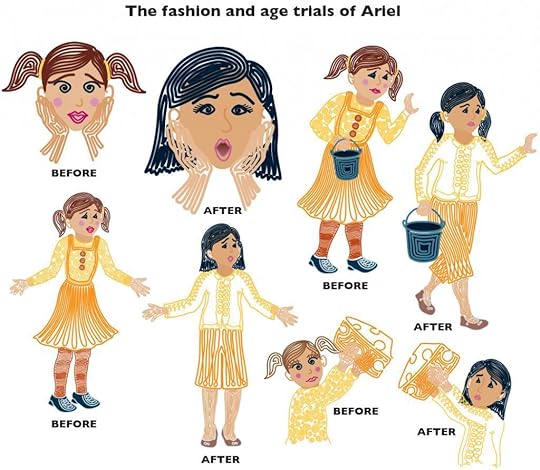
At first Ariel was the younger kid. To make her more like her namesake I made her older than Ben, as little kids tend to look up to older kids. Unless said kids are siblings. Then they are just annoying as they are always telling you what to do.
Ariel gets the job done no matter what. Give her a task, she’ll complete it in record time. Give her many tasks and she will sassily reply “…you want fries with that?” She’s normally calm in any situation but like any kid, she is prone to worrying about things out of her control. She can see the big picture, and uses her moral compass to guide her through decision-making. In short, Ariel ROCKS.
Our librarian friend in our children’s book group was the first to push for this continuity. I’m so glad I listened, even if it did take a year's convincing.
Though I was aiming to make them Asian, one friend thought the kids looked Latino, while another thought they looked Arabic! While I feel the look is decidedly ethnic, it does not seem to favor one over another. HOORAY for ambiguity!
Ariel was inspired by my niece. Unlike her brother, she was all for the character being named after her. But it felt a little unbalanced to blatantly take her identity (can’t I get arrested for that?). So, she became Ariel, which happens to be her middle name—So clever, if only to me!

At first Ariel was the younger kid. To make her more like her namesake I made her older than Ben, as little kids tend to look up to older kids. Unless said kids are siblings. Then they are just annoying as they are always telling you what to do.
Ariel gets the job done no matter what. Give her a task, she’ll complete it in record time. Give her many tasks and she will sassily reply “…you want fries with that?” She’s normally calm in any situation but like any kid, she is prone to worrying about things out of her control. She can see the big picture, and uses her moral compass to guide her through decision-making. In short, Ariel ROCKS.
Published on July 25, 2014 05:23
July 23, 2014
Characters: first up, BEN
In order to help me draw kids, I searched for photo references of kids running, chatting, eating, sleeping etc. When I needed a kid waving while skipping but couldn’t find that exact photo, I'd cut and paste a waving hand onto skipping body, which on occasion produced Frankenstein-ish results.
Getting the look of the boy right was the mere beginning of the struggle. In order for me to get YOU to believe that he is who I say he is, I had to develop a back story for him. This exercise is called a “character sketch.“ I had to invent the story of his life, including details that would never see the written page. In the end this helped ME to believe that much like Pinocchio, he IS a real boy. And that is how I make YOU believe!
As for name choice, originally I went for the low-hanging-fruit method of choosing: I wanted one boy hero and one girl hero, AND I happen to have one nephew and one niece. So I thought, DONE! But I ran into resistance from THE REAL BOY, who didn’t want his name used. I do get the last laugh because "Ben" was my nephew’s original choice for name.
I started writing about Ben as if describing a boy I knew: Ben is starry-eyed, gets distracted easily, and takes in the world as it unfolds. But he is also more about relying on instinct--more action-oriented. As he took shape in my head, it became easier to write about what he’d say and do, for it was just like recounting a story about a friend's kid.
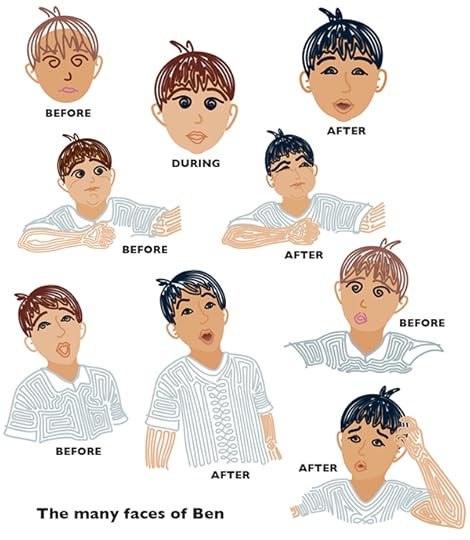
Backwards as this sounds, when I wrote book 2 for this series, I added more details to Centipede Dragon's character sketch, because characters should be ever evolving, just like the real living creatures that inspire them!
Getting the look of the boy right was the mere beginning of the struggle. In order for me to get YOU to believe that he is who I say he is, I had to develop a back story for him. This exercise is called a “character sketch.“ I had to invent the story of his life, including details that would never see the written page. In the end this helped ME to believe that much like Pinocchio, he IS a real boy. And that is how I make YOU believe!
As for name choice, originally I went for the low-hanging-fruit method of choosing: I wanted one boy hero and one girl hero, AND I happen to have one nephew and one niece. So I thought, DONE! But I ran into resistance from THE REAL BOY, who didn’t want his name used. I do get the last laugh because "Ben" was my nephew’s original choice for name.
I started writing about Ben as if describing a boy I knew: Ben is starry-eyed, gets distracted easily, and takes in the world as it unfolds. But he is also more about relying on instinct--more action-oriented. As he took shape in my head, it became easier to write about what he’d say and do, for it was just like recounting a story about a friend's kid.

Backwards as this sounds, when I wrote book 2 for this series, I added more details to Centipede Dragon's character sketch, because characters should be ever evolving, just like the real living creatures that inspire them!
Published on July 23, 2014 10:06
July 21, 2014
Characters: where did they come from?
Not only had Juli helped to edit my book and give me pause for thought, but she had also given me this book called Writing Picture Books, that someone had given to her. The author stated the importance of having children cast as “the heroes” because apparently, children don’t like see-reading about adults solving the problems.
I actually hadn’t wanted to draw ANY humans, because humans are hard, and made-up characters/animals are easy. But even in 2005 I realized that humans would have to come into the equation. I started searching for literal references like “Shepherd” and “farmer,” and so this picture includes my first attempt at human drawing.
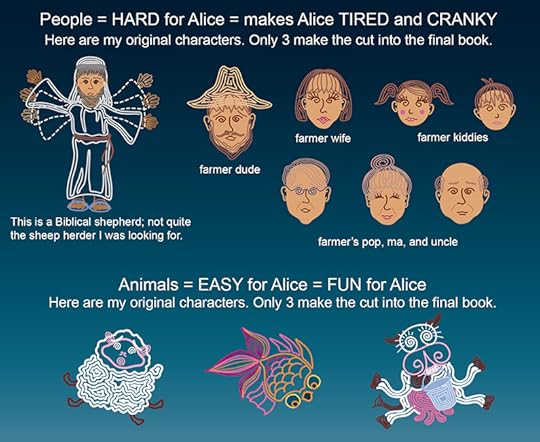
But with this new intelligence, it was clear that “Farmer” would have to be replaced with “Farmer’s kid.” SO, the next questions were: who should these characters be? How do they fit into the story? Does a kid get stuck in a well? Will they be friend or foe? And how on Earth will I learn to draw kids?
I actually hadn’t wanted to draw ANY humans, because humans are hard, and made-up characters/animals are easy. But even in 2005 I realized that humans would have to come into the equation. I started searching for literal references like “Shepherd” and “farmer,” and so this picture includes my first attempt at human drawing.

But with this new intelligence, it was clear that “Farmer” would have to be replaced with “Farmer’s kid.” SO, the next questions were: who should these characters be? How do they fit into the story? Does a kid get stuck in a well? Will they be friend or foe? And how on Earth will I learn to draw kids?
Published on July 21, 2014 05:29
July 18, 2014
Thanking the Academy part 1
In 2012, my friend J edited my manuscript through 13+ drafts. Editing is a BIG job that includes determining whether the plot hangs together with the character’s behavior. So after she read my first draft from 2005, she asked many good questions, one of which was, “Why does he want to help? What’s his motivation? WHY is he doing this?”
“Because he’s magical and NOT real.”
“Because he is part centipede and part dragon.”
“Because he’s bored.”
“Because I’m bored.”

MOTIVATION became the bane of my existence. But because of her gentle insistence that the character’s MOTIVATION has to be clear, I finally came up with a motive to which I hope many humans, big and small, can relate. Thanks J!
“Because he’s magical and NOT real.”
“Because he is part centipede and part dragon.”
“Because he’s bored.”
“Because I’m bored.”

MOTIVATION became the bane of my existence. But because of her gentle insistence that the character’s MOTIVATION has to be clear, I finally came up with a motive to which I hope many humans, big and small, can relate. Thanks J!
Published on July 18, 2014 05:15
July 16, 2014
About me, part 2
You can count that from 2005 until now, NINE years have elapsed. During that time I assure you I wasn’t doing NOTHING. I simply don’t remember all the SOMETHINGS I was doing.
Up until 2012, I had probably drawn hundreds of hearts, brains, livers, bones, cells, kidneys, vessels, stomachs, lungs, bladders, boy-parts, lady-parts, and poo. Yes, poo.
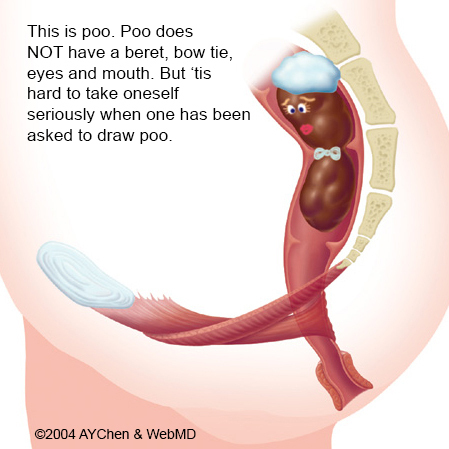
But my career took a “temporary hiatus” in the beginning of 2012. I took it as a sign from the Children’s Book God above, so from February to April I devoted myself to re-writing and illustrating the entirety of Centipede Dragon. And it was exhilarating! In a way hearts blah blah blah…poo were not. Don’t get me wrong, I love doing medical illustration, but this children’s book adventure comes from a LIFE.LONG.DREAM.
Up until 2012, I had probably drawn hundreds of hearts, brains, livers, bones, cells, kidneys, vessels, stomachs, lungs, bladders, boy-parts, lady-parts, and poo. Yes, poo.

But my career took a “temporary hiatus” in the beginning of 2012. I took it as a sign from the Children’s Book God above, so from February to April I devoted myself to re-writing and illustrating the entirety of Centipede Dragon. And it was exhilarating! In a way hearts blah blah blah…poo were not. Don’t get me wrong, I love doing medical illustration, but this children’s book adventure comes from a LIFE.LONG.DREAM.
Published on July 16, 2014 05:07
July 14, 2014
About him, part 2
At some point in my initial research effort, I found this written description: "Centipede dragon is a benevolent creature who takes the shape of many forms."
To me, benevolence evokes gentleness in a character that I frankly wasn’t intending to create. I was more interested in writing snarky, tongue-and-cheeky stories like Jon Scieszka does, who is simply one of the BEST children’s book writers EVER. No argument. No question. Just PERIOD. I wanted Loony Tunes “kill-da-wabbit” material; I mean who really cares about the kids! It's the adults who have to read this stuff night after night, right?
As bad as that sounds, it’s actually an important aspect to writing children’s books: you have to satisfy the person holding the wallet that expels the money for a sales person to take who then hands you a bag with a book in it. The kid isn’t going to think, “The psychological motivation driving Centipede Dragon’s actions exposes a decidedly human trait in him, that of craving a community to which to belong. I want this one Mommy.”
This is the sketch where I defined HOW Centipede Dragon bestows benevolence with his magic. It also cleverly (IMHO) ties back to that one description I found.

To me, benevolence evokes gentleness in a character that I frankly wasn’t intending to create. I was more interested in writing snarky, tongue-and-cheeky stories like Jon Scieszka does, who is simply one of the BEST children’s book writers EVER. No argument. No question. Just PERIOD. I wanted Loony Tunes “kill-da-wabbit” material; I mean who really cares about the kids! It's the adults who have to read this stuff night after night, right?
As bad as that sounds, it’s actually an important aspect to writing children’s books: you have to satisfy the person holding the wallet that expels the money for a sales person to take who then hands you a bag with a book in it. The kid isn’t going to think, “The psychological motivation driving Centipede Dragon’s actions exposes a decidedly human trait in him, that of craving a community to which to belong. I want this one Mommy.”
This is the sketch where I defined HOW Centipede Dragon bestows benevolence with his magic. It also cleverly (IMHO) ties back to that one description I found.

Published on July 14, 2014 05:14
July 11, 2014
About me AND him
When we last left off, my sister was warning me that cocaine could derail my children’s book aspirations.
The rewrite was laborious for a teen with little focus, and though you would think the illustrations would be the easy part for me, my lack of ability back then ended in pursuing medical school as a career instead.
So by the time I got back to children’s books, I had finished college, did NOT go to med school, worked my first job as a lab tech at the NIH, moved to Canada for grad school and found a way to torture myself with cadaver dissection without the payoff of a medical degree, worked my first medical illustrator job, and moved to New York for my second, third and fourth jobs.
On a visit to Toronto in 2005, I saw that fateful symbol at an exhibit on Indigo-dyed batik textiles. There were many symbols depicted, but none caught my eye like this one.
In 2012, I found more images. Now, I’m injecting my own ignorant opinion here with my initial impressions, but take a look in particular at the version in the upper right corner…can you guess which one was my favorite?
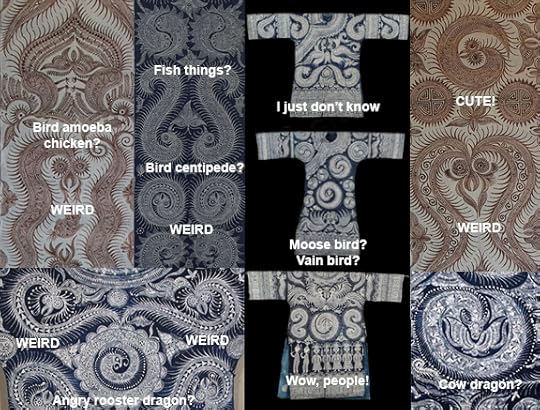
The rewrite was laborious for a teen with little focus, and though you would think the illustrations would be the easy part for me, my lack of ability back then ended in pursuing medical school as a career instead.
So by the time I got back to children’s books, I had finished college, did NOT go to med school, worked my first job as a lab tech at the NIH, moved to Canada for grad school and found a way to torture myself with cadaver dissection without the payoff of a medical degree, worked my first medical illustrator job, and moved to New York for my second, third and fourth jobs.
On a visit to Toronto in 2005, I saw that fateful symbol at an exhibit on Indigo-dyed batik textiles. There were many symbols depicted, but none caught my eye like this one.
In 2012, I found more images. Now, I’m injecting my own ignorant opinion here with my initial impressions, but take a look in particular at the version in the upper right corner…can you guess which one was my favorite?

Published on July 11, 2014 05:36
July 7, 2014
About me, part 1
So, how did I get started with all this? Way before I even knew that there was such a thing as being a medical illustrator, I wrote my first story at age 14-15, about an Inuit named Indigo and his sidekick penguin friend, Pinnafore. I was really into penguins back then, so Indigo was really Pinnafore’s sidekick.
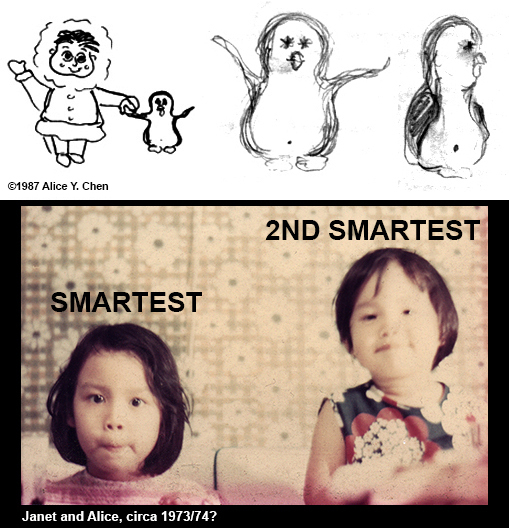
Indigo and Pinnafore were explorers, though they never actually went anywhere because Indigo was a kid and Pinnafore was, well, a penguin.
Indigo started out as "Escobar Eskimo," which sent my sister, Janet, into a lather. She was always the smarter one of us two. She told me that a big-time Colombian drug dealer named Pablo ESCOBAR had just been arrested, so unless I wanted my adventuring duo to be synonymous with cocaine, I had better change his name! She also scolded me for using the ethnically incorrect term "eskimo."
That radically changed my book, considering that now everything that rhymed with "Escobar" or "Eskimo," had to now rhyme with "Indigo" or "Inuit." Already I was in over my head.

Indigo and Pinnafore were explorers, though they never actually went anywhere because Indigo was a kid and Pinnafore was, well, a penguin.
Indigo started out as "Escobar Eskimo," which sent my sister, Janet, into a lather. She was always the smarter one of us two. She told me that a big-time Colombian drug dealer named Pablo ESCOBAR had just been arrested, so unless I wanted my adventuring duo to be synonymous with cocaine, I had better change his name! She also scolded me for using the ethnically incorrect term "eskimo."
That radically changed my book, considering that now everything that rhymed with "Escobar" or "Eskimo," had to now rhyme with "Indigo" or "Inuit." Already I was in over my head.
Published on July 07, 2014 05:28



